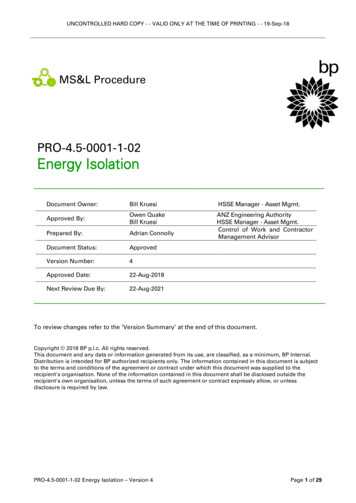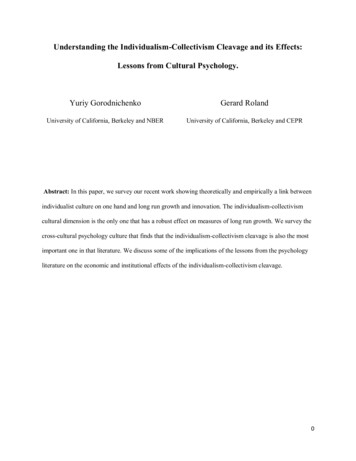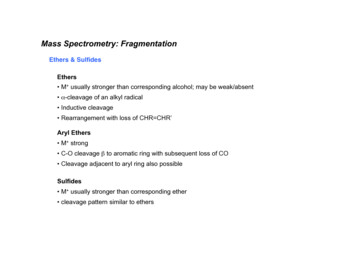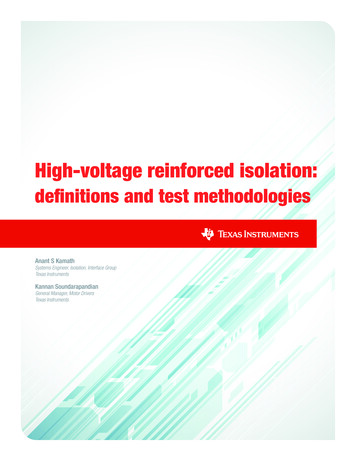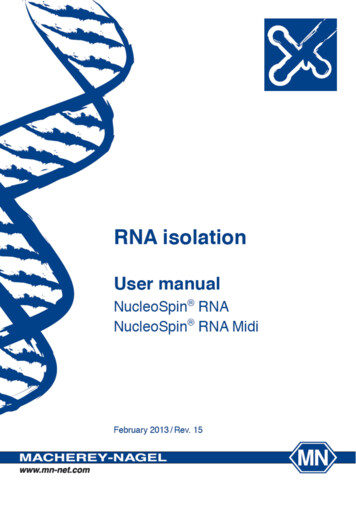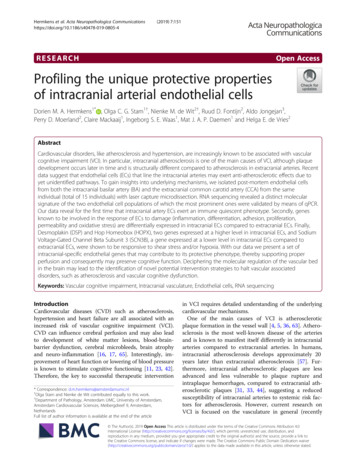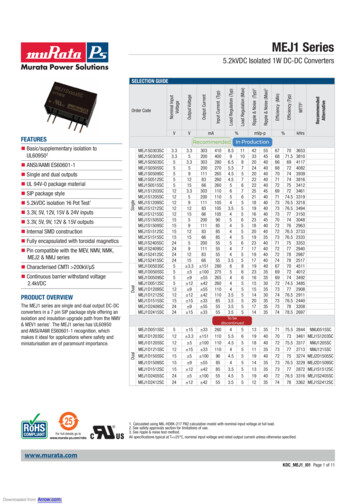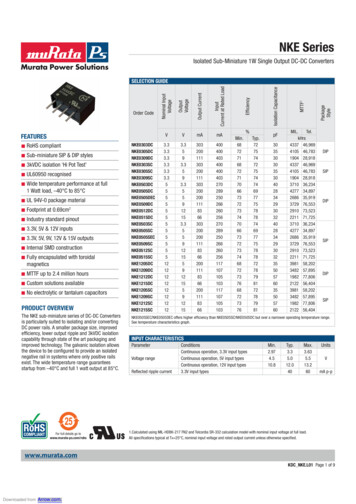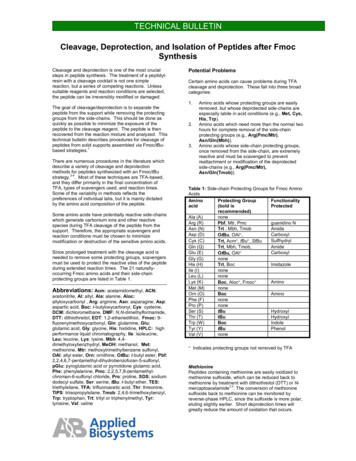
Transcription
TECHNICAL BULLETINCleavage, Deprotection, and Isolation of Peptides after FmocSynthesisCleavage and deprotection is one of the most crucialsteps in peptide synthesis. The treatment of a peptidylresin with a cleavage cocktail is not one simplereaction, but a series of competing reactions. Unlesssuitable reagents and reaction conditions are selected,the peptide can be irreversibly modified or damaged.The goal of cleavage/deprotection is to separate thepeptide from the support while removing the protectinggroups from the side-chains. This should be done asquickly as possible to minimize the exposure of thepeptide to the cleavage reagent. The peptide is thenrecovered from the reaction mixture and analyzed. Thistechnical bulletin describes procedures for cleavage ofpeptides from solid supports assembled via Fmoc/tBu1based strategies.There are numerous procedures in the literature whichdescribe a variety of cleavage and deprotectionmethods for peptides synthesized with an Fmoc/tBu2-4strategy. . Most of these techniques are TFA-based,and they differ primarily in the final concentration ofTFA, types of scavengers used, and reaction times.Some of the variablity in methods reflects thepreferences of individual labs, but it is mainly dictatedby the amino acid composition of the peptide.Some amino acids have potentially reactive side-chainswhich generate carbonium ions and other reactivespecies during TFA cleavage of the peptide from thesupport. Therefore, the appropriate scavengers andreaction conditions must be chosen to minimizemodification or destruction of the sensitive amino acids.Since prolonged treatment with the cleavage acid isneeded to remove some protecting groups, scavengersmust be used to protect the reactive sites of the peptideduring extended reaction times. The 21 naturallyoccurring Fmoc amino acids and their side-chainprotecting groups are listed in Table -------------------------Abbreviations: Acm: acetamidomethyl, ACN:acetonitrile, Al: allyl, Ala: alanine, Aloc:allyloxycarbonyl , Arg: arginine, Asn: asparagine, Asp:aspartic acid, Boc: t-butyloxycarbonyl, Cys: cysteine,DCM: dichloromethane, DMF: N,N-dimethylformamide,DTT: dithiothreitol, EDT: 1,2-ethanedithiol, Fmoc: 9fluorenylmethoxycarbonyl, Gln: glutamine, Glu:glutamic acid, Gly: glycine, His: histidine, HPLC: highperformance liquid chromatography, Ile: isoleucine,Leu: leucine, Lys: lysine, Mbh: 4,4dimethyloxybenzhydryl, MeOH: methanol, Met:methionine, Mtr: methoxytrimethylbenzene sulfonyl,OAl: allyl ester, Orn: ornithine, OtBu: t-butyl ester, onyl,pGlu: pyroglutamic acid or pyrrolidone glutamic acid,Phe: phenylalanine, Pmc: 2,2,5,7,8-pentamethylchroman-6-sulfonyl chloride, Pro: proline, SDS: sodiumdodecyl sulfate, Ser: serine, tBu: t-butyl ether, TES:triethylsilane, TFA: trifluoroacetic acid, Thr: threonine,TIPS: triisopropylsilane, Tmob: 2,4,6-trimethoxybenzyl,Trp: tryptophan, Trt: trityl or triphenylmethyl, Tyr:tyrosine, Val: valinePotential ProblemsCertain amino acids can cause problems during TFAcleavage and deprotection. These fall into three broadcategories:1.2.3.Amino acids whose protecting groups are easilyremoved, but whose deprotected side-chains areespecially labile in acid conditions (e.g., Met, Cys,His, Trp).Amino acids which need more than the normal twohours for complete removal of the side-chainprotecting groups (e.g., Arg(Pmc/Mtr),Asn/Gln(Mbh)).Amino acids whose side-chain protecting groups,once removed from the side-chain, are extremelyreactive and must be scavenged to preventreattachment or modification of the deprotectedside-chains (e.g., Arg(Pmc/Mtr),Asn/Gln(Tmob)).Table 1: Side-chain Protecting Groups for Fmoc AminoAcidsAminoProtecting GroupFunctionalityacid(bold isProtectedrecommended)Ala (A)noneArg (R)Pbf, Mtr, Pmcguanidino NAsn (N)Trt , Mbh, TmobAmideAsp (D)CarboxylOtBu, OAl ,Cys (C)SulfhydrylTrt, Acm , tBu , StBuGln (Q)Trt, Mbh, Tmob,AmideGlu (E)CarboxylOtBu, OAl Gly (G)noneHis (H)Trt, BocImidazoleIle (I)noneLeu (L)noneLys (K)AminoBoc, Aloc , Fmoc Met (M)noneOrn (O)BocAminoPhe (F)nonePro (P)noneSer (S)tBuHydroxylThr (T)tBuHydroxylTrp (W)BocIndoleTyr (Y)tBuPhenolVal (V)none Indicates protecting groups not removed by TFAMethioninePeptides containing methionine are easily oxidized tomethionine sulfoxide, which can be reduced back tomethionine by treatment with dithiothreitol (DTT) or N2,3mercaptoacetamide . The conversion of methioninesulfoxide back to methionine can be monitored byreverse-phase HPLC, since the sulfoxide is more polar,eluting slightly earlier. Short deprotection times willgreatly reduce the amount of oxidation that occurs.
CysteinePeptides containing cysteine are prone tooxidative formation of disulfide bonds, which can formintramolecularly, forming a cyclic peptide, or2intermolecularly, resulting in oligomerization . If morethan one cysteine is present in a molecule,intramolecular disulfides will cause aggregation of the5peptide molecules . Disulfide bonds can be reducedusing DTT. However, some aggregates are verydifficult to reduce. Since oxidation occurs mostfrequently after exposure of the deprotected peptide toair, care should be taken to keep the peptide asanaerobic as possible when multiple cysteines arepresent. When multiple cysteines are present, and theuser wishes to direct disulfide bond formation to specificsites, it is recommended that different protectinggroups, which are removed in different manners, beutilized (refer to Table 1).ones are present, and the Tmob group is difficult toscavenge. However, the Trt group is readily removed4and easily scavenged . N-terminal Gln(Trt) may needextended cleavage times. However, N-terminalglutamine can also undergo a cyclization to form2pyroglutamic acid . While it can occur slowly at basic orneutral pH, it is most commonly seen under highlyacidic conditions (as in cleavage/ deprotection).Deprotection times under 4 hours will greatly reduce thechances of this occurring. Like Asn, Gln(Cpd) has11proven useful for N-terminal glutamineArginineMtr-protected arginine requires long deprotection3,12,13. When multiple Arg(Mtr) are present in thetimespeptide, deprotection times of up to 12 hours may berequired! Pmc-protection has greatly reduced this13time , but it can still take more than 4 hours whenmultiple Arg(Pmc) are present. Pmc is also difficult toscavenge and has a tendency to reattach or alkylatesensitive residues. The use of Pbf-protection forarginine is therefore strongly recommended, sincedeprotection times, even with multiple Arg(Pbf) present,are under 4 hours (2 hours is usual), and the Pbf group14is easily scavenged .Formation of an undesired impurity ( 51 Da by positiveion mode MALDI-TOF) has been seen during the6synthesis of C-terminal cysteine-containing peptides .The amount of this impurity is dependent on thepolymeric support, the side-chain protecting group, thelinker incorporated to anchor the cysteine to the resin,and the state of the Nα-amino group during chainelongation. The reaction is minimized by using Trtprotection and PEG-PS supports.Isolation of the Peptide from the SolidSupportTryptophanThe indole ring of tryptophan is susceptible to bothoxidation and alkylation by unscavenged protecting2-4groups released by other side-chains . Oxidationproducts of tryptophan generally cannot be reversed byreduction. Use of Boc-protected tryptophan, andminimal exposure to the cleavage cocktail, will reduce7the chances of indole ring damage . C-terminaltryptophan-containing peptides are also known to1,8undergo reattachment to the resin . This undesiredback-alkylation can be prevented by the use of FmocXAL-PEG-PS for the construction of C-terminal9amides .Various cleavage cocktails have been reported in theliterature and are typically applied to peptides basedupon their amino acid composition. Unfortunately, nosingle cleavage and deprotection procedure is optimalfor all peptides. This technical bulletin is meant as aguide to simplify the selection of cleavage cocktailsbased upon both the nature of the linker and the aminoacid composition of the peptide.The overall scheme for a post-synthetic work-up isshown in Figure 1. This figure outlines a generalstrategy for isolation of a peptide from a polymericsupport. More detailed schemes for selecting theprocedures that are appropriate for the amino acidsequence of the synthesized peptide are shown inFigures 2-5.Histidine8The imidazole ring in histidine can be acylated . Shortdeprotection times will reduce the chances of damage.SYNTHESIS COMPLETETyrosineAlthough unlikely, the side-chain of tyrosine can bealkylated by unscavenged protecting groups released3by other side-chains . Peptides containing C-terminal1tyrosine may undergo reattachment to the resin .Preparation of Support1. Wash with DCM or MeOH2. Remove from synthesizer3. Vacuum dry the resinDRY, SUPPORT-BOUND PEPTIDEAsparagineDehydration of unprotected asparagine can occur3during coupling . Therefore, a protecting group isrecommended. The Mbh group may require longerdeprotection times, especially when multiple ones arepresent, and the Tmob group is difficult to scavenge.However, the Trt group is readily removed and easilyscavenged. N-terminal Asn(Trt) may need extended4,10cleavage times . Use of the faster deprotectingcyclopropyldimethylcarbinyl (Cpd)-group for N-terminal11Asn has proven useful .Based on amino acid composition,choose cleavage cocktail and conditionsCleavage/ DeprotectionCleave and deprotectPEPTIDE BYPRODUCTS REAGENT PROTECTING GROUPS SUPPORTBased on size and hydrophobicity,choose method of peptide isolationIsolation of PeptideGlutamineLike asparagine, dehydration of unprotected glutamine3can occur during coupling . Therefore, a protectinggroup is recommended. The Mbh group may requirelonger deprotection times, especially when multiple1. Precipitate or extract2. LyophilizeCRUDE PEPTIDEFigure 1: Post-Synthetic Work-up Scheme2
For fully deprotected and acid-sensitive peptides, useone of the following methods:NOTE: Since cleavage/deprotection is a chemicalreaction in which bonds are irreversibly broken, itis recommended that an initial trial cleavage usinga small amount of the resin (50-100 mg) beperformed to verify the proper conditions. TFA/DCM (1:19) for one hour, followed byTFA/DCM (1:1) for 1 hour. Add scavengersas appropriate. Scavengers are necessaryonly for the removal of Pmc, Pbf, and/orTmob groups. High concentration of TFA (see Table 2) for 2hours.LinkersThere is a wide range of commercially availablepolymeric supports with linkers (anchors) attached tothe resin. The linker provides a point of attachment forthe C-terminal amino acid, and the structure of thelinker determines the method of cleavage and thefunctionality of the final product. The nature of the15cleavage cocktail selected is dependent on the linker .High concentrations of TFAThe most commonly used supports for peptidesynthesis are those cleaved with a high concentrationof TFA. The most common cleavage cocktails are listedin Table 2.Low concentrations of TFAPeptides synthesized on supports with a XAL (“Seiber”)or HAL linker are cleaved in low percentages of TFA toyield fully-protected peptide amides or peptide acidsrespectively.All cleavage cocktails must be prepared fresh prior touse. Scavengers should also be fresh. Buy them insmall quantities, and discard any unused scavengerafter a few months.High Concentrations of TFAPeptides synthesized on supports with a PAC (“Wang”),PAL, AM (“Rink Amide”), or BAL linker are cleaved inhigh percentages of TFA to yield fully deprotectedpeptides. There are numerous cleavage cocktails citedin the literature for cleavage of peptides from these typeof supports.Reagents R and B, which are compatible with mostsequences, are highly recommended for those peptidescontaining Trp, His, Met, Cys, Arg(Mtr/Pmc),Asn(Mbh/Tmob), Gln(Mbh/Tmob), as well as forpeptides constructed on a PAL or Rink Amide resin(See Figure 2). While Reagent R may give highercleavage yields, it is highly noxious and may not bepreferable to handle. Reagent R or B are alsorecommended when extended cleavage times (those inexcess of 2 hours) are needed, since these cocktailscontain a mixture of additives, some of whichaccelerate cleavage from the resin and scavengereactive carbocations produced duringcleavage/deprotection.Other LinkersLinkers have been developed that release peptidesfrom the solid support upon treatment with reagentsother than TFA. These include Linker B (or KB) , whichis base-labile, Hycram (an allyl linker), “Safety-catch”,and photolabile linkers. These are not commonly used,and are, therefore, out of the scope of this technicalbulletin. For cleavage of peptides from these types ofsupports, please contact your vendor.DRY, SUPPORT-BOUND PEPTIDEChoosing the Cleavage CocktailThe selection of the cleavage cocktail depends on thenature of the cleavable linker attaching the peptide tothe support, the nature of the protecting groups and thereactive properties of the unprotected side-chain.Are any of the following amino acids present?Arg (Mtr/Pmc), Asn (Mbh/Tmob), Gln (Mbh/Tmob),Trp (any), Met (any), Cys(any), His (any).YESLow concentrations of TFAPeptides synthesized on supports with a XAL or HALlinker are cleaved in low concentrations of TFA, and aretypically used to prepare protected fragments orsequences containing acid-sensitiveresidues, such as N-methyl amino acids (e.g.cyclosporin).1. Use Reagent R or B (see Table 2)2. React for 2 or more hours *1 x 1 hour 6 x 5 minutes1. Use any cocktail onTable 2.2. React for 2 hours.*Reaction times:Arg(Mtr): one 4 hourstwo or more 8-12 hours.Do not use with Trp.Asn(Mbh/Tmob): 4 hours.Gln(Mbh/Tmob): 4 hours.Trp (any): 2-4 hours maximum.Unprotected Trp: Protect from light.Blanket with N2.Cys (any), His (any), Met (any): 2 hours.Blanket with N2.For protected peptides and fragments, cleave from theresin using TFA/DCM (1:99) and allow to react usingone of the following methods: NOFigure 2. Choice of Cleavage/Deprotection Cocktail(High conc. of TFA) and Reaction Times.3
Table 2: Fmoc Cleavage Cocktails: HighConcentrations of TFA.BKK’LPP RT1.2.3.RecipeTFA/phenol/water/TIPS ol(82.5/5/5/5/2.5)TFA/DTT/Water/TIPS (88/5/5/2)TFA/phenol(95/5)Hrs1-4Comments1All peptides .1-4All peptides .1-4All peptides .TFA/phenol/Methanesulfonicacid FA/TES (95/5)15minTFA/water (95/5)1-4TFA/DCM/indole(70/28/2)1-4elute differently from unprotected peptides, and mayalso absorb at different wavelengths, it may be possibleto monitor the disappearance of the protected peptideover the course of the cleavage reaction. It is importantto realize that due to differences in the extinctioncoefficients, there is no direct correlation between peakheights/areas of protected peptides and their actualpercentage in the peptide mixture. For example, apeptide containing a small percentage of protectedArg(Mtr) may show two peaks of equal height.11NOTE: Met, Cys and unprotected Trp may bemodified during prolonged acid treatment, even inthe presence of scavengers. Take care to excludeoxygen and light. Do not let cleavage times exceed4 hours. One to two hours is optimal.11-4All peptides1-4tBu group. Donot use with Trp,Met or Cys.1,2All peptides .Cleavage Cocktail PreparationCleavage cocktails must be prepared fresh using highquality TFA and fresh scavengers. Depending on theamino acid composition of the peptide (see Figure 2and Table 2), select a cleavage cocktail and preparethe appropriate amount for the reaction scale.11-8All peptides .1-4Boc, tBu,Trt. Donot use with Argor Trp.Boc, tBu, Trt,3Pbf . Do not usewith Trp, Met orCys.Do not use with1Arg .CAUTION:Preparation of cleavage cocktails and thecleavage/deprotection reaction must be done in awell-vented fume hood.For most applications, 5-10 mL of cocktail is required.It is convenient to dedicate a set of glassware to thehandling of cleavage cocktails.Thiol scavengers are especially noxious. It isrecommended that a large beaker containing a 50%aqueous bleach solution be kept in the fume hood, andall glassware and disposables, such as pipette tips andgloves, be allowed to soak in this solution for severaldays before cleaning or disposal.Possible alkylation of unprotected tryptophanresidues.Possible deamidation of Asn and Gln residues.May be used if one Arg(Pbf) is present. Moderatesuccess if more than one Arg(Pbf) is present.Amount of Cleavage Cocktail to UseRequisite Chemicals and EquipmentThe amount of cleavage cocktail used depends on boththe amount of the resin and its properties. Polyethylene glycol-grafted polystyrene (PEG-PS)supports and polystyrene (PS) supports swelldifferently. PS supports float in the TFA. Enoughcocktail solution should be used to saturate and swellthe resin, with about 2-3 mm of clear solution below thefloating beads. PEG-PS supports swell in TFA, and donot float. Use enough cocktail solution to swell theresin. This is approximately 5 mL of cleavage cocktailfor 0.5 g of resin. Choosing the Reaction TimeWith most linkers, the peptide-resin anchoring is fullysevered following a two-hour treatment with TFA.However, longer times may be necessary for thecomplete removal of some of the side-chain protectinggroups. A guide to reaction times is provided in Figure 2.Optimal conditions should be determined using an initialtrial cleavage. Using HPLC to monitor the efficiency ofthe removal of the side-chain protecting groups overtime can be a useful tool. Since protected peptides will4Gloves, goggles and protective clothingTFA (sequencing grade)Scavengers [thioanisole, EDT, anisole,phenol, TIPS, etc.] (reagent grade)Peroxide-free anhydrous diethyl ether,cooled in an explosion-proof freezer or in adry ice/acetone bath.Household bleachNitrogen or argon (pre-purified), forblanketing the reaction mixtureScintillation vials with polypropylene capinserts, for the cleavage reactionPasteur pipettes and glass wool, orpolypropylene syringes with polypropylenefrits and rubber septa (see Figure 3)Glacial acetic acidDry iceBenchtop centrifuge (for 50 mL tubes)50 mL centrifuge tubesLyophilizer10 mL and 25 mL graduated cylindersAutomatic pipettorsMiscellaneous glassware: flasks, beakersRotary evaporator (optional)Magnetic stirrer and stirbars (optional)
1.Wash the resin with DMF.2.Wash the resin with DCM.3.Add the appropriate cleavage cocktail to thepeptidyl-resin.4.Mix the solution periodically or bubble nitrogenthrough the solution.If the peptide contains Trt-protected amino acids (Cys,His, Asn, Gln) the resin may turn deep yellow during thecleavage reaction. This is due to the trityl carboniumion chromophore, which is produced when theprotecting group is removed under acidic conditions.If cleavage is performed on a PAL or Rink amide resinwith a cocktail other than Reagent R or B, the resin mayturn from pink to red, depending on the amount ofscavengers in the cleavage cocktail. This should noteffect the peptide quality.Figure 3. Cleavage ApparatusSeparating the Cleaved Peptide from theSupportReagent PreparationTo induce peptide precipitation, add the cleavagemixture dropwise to cold (-20ºC) ether. The non-peptideproducts remain in the ether solution.Below is a typical procedure for the preparation of acleavage cocktail, and it is applicable to any cocktailsolution.Until the peptide is analyzed, it is recommended thatneither the ether solution nor the resin be discarded,and that they be stored under nitrogen or argon at 0ºC.Reagent R:To prepare 10 mL of Reagent R, use the following (byvolume):TFA:Thioanisole:EDT:Anisole:1.2.3.NOTE: Some small (less than 6 amino acids) orhydrophobic peptides may not precipitate whenadded to the ether and must be isolated byalternative methods. In this event, dry down theether, dissolve the peptide in 10% aqueous aceticacid, and extract with chloroform. Other possiblecauses for no precipitate and hints for peptiderecovery are provided at the end of this section.9.0 mL (90%)0.5 mL (5%)0.3 mL (3%)0.2 mL (2%)Add the scavengers to a graduated cylinder (10 or25 mL ) with an automatic pipettor.Dilute with the TFA.Mix vigorously for 30 seconds via shaking ornitrogen bubbling (recommended for sequencescontaining Cys or Met).The separation of the peptide solution from the supportcan be performed using a variety of techniquesprovided that the addition of the solution to the ether isdropwise. The following procedure is the simplest:For those cocktails containing phenol, use phenolcrystals, not liquified phenol. The crystals may eitherbe weighed out (w/v) or be melted and the subsequentliquid delivered to the graduated cylinder (v/v).1. Prepare a filter to retain the resin particles either byplacing a small plug of glass wool into the neck of a9” pasteur pipette or by placing a polypropylene fritinto a disposable polypropylene syringe (see Figure3).The Cleavage/Deprotection Reaction2. Clamp the filter over a container containing at least a10-fold excess of cold (-20 ºC) diethyl ether.Reagents R and B are compatible with most sequences(see Figure 2 and Table 2), and are stronglyrecommended for sequences containing Trp, His, Met,Cys, Arg (Mtr/Pmc), Gln (Mbh/Tmob), orAsn(Mbh/Tmob), as well as for peptides constructed ona PAL or Rink Amide resin.3. Add the cleavage mixture dropwise to the filter.Minimize the amount of support transferred toprevent clogging of the filter.A white precipitate should appear in the ether asthe drops hit the surface. The greater the amountof peptide material per drop, the greater theprobability of precipitation; therefore, maintain acleavage volume as low as possible.NOTE: It is strongly recommended that an initialtrial cleavage using a small amount of the resin(50-100 mg) be performed to verify the properconditions.If a precipitate has not formed following the additionof 10 drops of the cleavage solution to the coldether, stop adding the cleavage solution and5
observe the ether solution. If no visible precipitateappears after 10 minutes, use the chloroformextraction procedure given later in this section.4.Rinse the support with a small volume of cleavagecocktail or TFA.5.Once the peptide has been precipitated and theresin washed, chill the ether solution in the freezeror in a dry ice/acetone bath. For maximumrecovery, incubate the ether-peptide mixture at4ºC overnight.6.Collect the precipitated material by filtration orcentrifugation.7.Wash the precipitate at least three times with coldether to remove any residual scavengers.8.Dissolve the peptide in glacial acetic acid, shellfreeze and lyophilize.Wash the support again with DCM, thoroughly dryunder vacuum, and repeat the cleavage reaction.NOTE: The precipitate dried directly from the ethergives a TFA salt. TFA salts may affect the pH ofpeptide solutions or the viability of cells in culture.Lyophilization from acetic acid replaces the TFAsalt with an acetate salt, which allows easierhandling of the peptide and removes trace amountsof scavengers.4.Prolonged acid treatment may break sensitiveamide bonds, such as those between Asp andPro, producing fragments of the peptide.5.The peptide reattached to the resin-bound cationsvia electron-rich side-chains during the cleavagereaction. This has been reported in peptidescontaining C-terminal Trp, Tyr and Met, and mayresult in drastically decreased yields. This is anundesirable side-reaction that may be minimizedby choosing the appropriate scavengers in thepresence of susceptible amino acids. If ReagentR or B is used and a low yield is obtained, suspectincorrect preparation, or poor quality scavengers Ifthis happens, you must repeat the synthesis.6.Poor quality TFA or scavengers may result in anyof the above problems. Recovery may not bepossible, but try repeating the cleavage reactionafter washing and drying the support.Chloroform ExtractionIf the peptide did not precipitate from the ether, it maybe possible to extract the undesired by-products intochloroform using the following procedure:NOTE: Do not discard the support or the ether untilthe peptide is analyzed. Blanket it with nitrogen orargon and store in the cold.1.Dry down the TFA-peptide mixture under highvacuum (equipped with a proper trap), or rotaryevaporate. If the cleavage cocktail containedthiols, this mixture will be highly noxious.No Formation of Precipitate upon EtherTreatment2.Dissolve the residue in 10-20% aqueous aceticacid (1-5 mL).The following are several reasons that a precipitatemay not form:3.Transfer into a separatory funnel and add a twofold volume of chloroform.1. Peptides which are less than 6 amino acids and/orvery hydrophobic may be difficult to precipitate. Analternative work-up is to evaporate the ether,dissolve the sample in 10% aqueous acetic acid,and extract the organic scavengers and byproductswith chloroform.4.Mix thoroughly by shaking (periodically relieve thepressure by removing the stopper) and allow thelayers to separate.NOTE: The separation of the layers may takeseveral hours. Gradual swirling will accelerate theprocess. Separation of the layers is consideredcomplete when the two layers are entirely clear.2. The peptide may be cleaved, but binds to thesupport. Additional washing of the resin with TFAmay be needed to remove the peptide from thesupport.3. The peptide may still be covalently attached to thesupport; cleavage from the support did not occur orwas very inefficient due to the following:i.DMF was not replaced by a volatilesolvent before the peptide was dried,contaminating the resin and interferingwith acidolysis.ii.The support was washed with DCM butnot thoroughly dried. A supportcontaining DCM reduces the TFAconcentration in the cleavage cocktail,resulting in a less efficient cleavagereaction and low yields.5.Remove the organic layer (the bottom one) whichcontains the protecting groups and non-volatile byproducts.6.Repeat the extraction of the aqueous layer (steps3-5) twice.NOTE: The time for the two layers to separatedecreases with each subsequent extraction.67.Dry the aqueous layer under high vacuum.8.Dissolve the residue in glacial acetic acid, shellfreeze, and lyophilize.
Table 3. Hydrophobicity Scales for Amino Acid SidechainsAnalysis and Purification of the CrudePeptideAmino AcidHydrophobic PeptidesAla (A)Arg (R)Asn (N)Asp (D)Cys (C)Gln (Q)Glu (E)Gly (G)His (H)Ile (I)Leu (L)Lys (K)Met (M)Phe (F)Pro (P)Ser (S)Thr (T)Trp (W)Tyr (Y)Val (V)Amino acids are frequently grouped according to thepolarity of the side-chains.Non-Polar (Hydrophobic):small:Cys, Pro, Ala, Thrlarge:Val, Ile, Leu, Met, PhePolar (Hydrophilic):small:large:Ser, Gly, Asp, AsnGlu, Gln, Lys, ArgThe hydrophobicity values of amino acid side-chainsare listed in Table 3, and their corresponding plots areshown in Figure 5.These values may be used as a guide when trying todetermine if a given peptide is likely to precipitate fromthe ether after the cleavage reaction, as well as toapproximate chromatographic behavior.The first column of Table 3 contains the Kyte andDoolittle hydropathy scale, which is often used topredict hydrophobic regions in proteins and peptides(the “grease plot”). The numerical values represent aconsensus from studies of partitioning the individualamino acids between organic solvent and water, andthe positions of the amino acids within a folded proteinas determined from crystal data. The most hydrophobicpeptides possess a value of 4.5; the least .22Souces:J. Kyte and R.F. Doolittle 1982. J. Mol. Bio. 157:105.Consensus scale from partition experiments andamino acid distributions in proteins from crystal data.Scale: most hydrophobic: 4.5 to least hydrophobic: 4.5.J.L. Fauchere and V. Pliska 1983. Eur. J. Med. Chem.10:369. Derived from partition measurements ofamino acids between water and octanol, relative toGly. Scale: most hydrophobic: 2.25 to leasthydrophobic: -1.01.HydrophobicityKyte and Doolittle scales are based partiallyon crystal data, and reflect the inside-outside positionsof folded proteins, presumably in their native state.These values may not always correlate to thedenatured state of synthetic peptides. Partition data ofamino acid side-chains between water and octanol,referred to as Fauchere and Pliska values, are listed inthe second column of Table 3. The alpha amino andcarboxyl groups of the individual amino acids weremasked, and partition coefficients for the various sidechains were compared to Gly (side-chain H).Although values for some amino acids vary betweenthe two scales, the hydrophobic residues Ile, Val, Leu,Phe, Cys, and Met, and the hydrophilic residues Arg,Lys, Asp, Glu, Asn, and Gln are closely grouped. Itshould be noted that both the Kyte and Doolittle andFauchere and Pliska scales are only estimates of thehydrophobic properties of a peptide. The actualsolubility characteristics of a peptide may differ fromtheir calculated values.A43210-1GTSWYPHEQDNKRI V LFCMAHydrophilicityTrp, Tyr, HisFauchere & Pliska-2-3Hydrophobicity-4B21GSQNEDKR0-1-2WI FLCMVYPATH.HydrophilicityIntermediate polarity:large:Kyte -3.91.92.8-1.6-0.8-0.7-0.9-1.34.2A: Kyte and Doolittle values, based on consensus ofpartition and crystal data.B: Fauchere and Pliska scale, reflecting partition dataonlyFigure 5. Hydrophobicity Plots of Amino Acid Sidechains7
The Solubility ProblemHints on Storage and Handling of SyntheticPeptidesMany crude synthetic peptides, especially those thatwere precipitated and dried several times, may benotoriously insoluble in standard HPLC solvents, due tothe following reasons:1.A high content of hydrophobic residues; thesepeptides tend to “oil-out” and form compactclusters to minimize contact with water andmaximize hydrophobic interactions.2.Non
peptide to the cleavage reagent. The peptide is then recovered from the reaction mixture and analyzed. This technical bulletin describes procedures for cleavage of peptides from solid supports assembled via Fmoc/tBu-based strategies.1 2. Amino acids which need more than the normal two hours for complete removal of the side-chain
